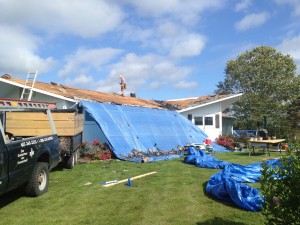Above: A video of a shingle roof repair in Owego.
Most likely the roof you have now is an asphalt shingle roof of the “3-tab” type. Asphalt naturally repels water, and it’s a readily available commodity so long as we continue to use crude oil. The ceramic granules on the face of the shingles protect the asphalt from breaking down in the sun. Asphalt is a by-product of refining crude oil. While they still make 3-tab shingles, they only come with a 30-year warranty. At Alpine, we highly recommend spending slightly more for architectural shingles.
Architectural shingles are also known as laminated or dimensional shingles. They are among the highest quality roofing products because they are heavier, without requiring additional support under the roof. Their weight and design give a three-dimensional appearance. Some are nailed on in the usual way, while others in addition to nails, have interlocking tabs. They are made using a heavier mat base than a standard asphalt shingle. The mat base is made from fiberglass or organic materials, with asphalt added. The back of the shingles are coated with a special material and granules are added to the top layer.

Left: Architectural Shingles
In most cases they’re designed to last for 30-50 years. They contain asphalt and minerals, are strong and flexible. They withstand extreme temperatures and other weather events. They are often available with a lifetime warranty.
The heaviest are rated to withstand winds up to 120 mph, heavy hail and other impact. The interlocking models hold together extremely well. They are also highly fire resistant.
Shingles may be subject to algae and mildew damage if wet leaves and other materials build up. If you live in an area subject to these conditions consider this type of shingle with some copper included in the materials.
Also, shingles are like the feathers on a duck’s back – they are designed to shed water very well, but are not watertight when water pushes upward. In areas where ice and snow build up, especially in the spring thawing/freezing cycle leaks can occur. At Alpine we install Ice and Water Shield on all eave and rake edges to prevent that and use high quality synthetic roofing underlayment.Installing a roof vent is also highly recommended if there isn’t one already there.
Right: A shingle roof in Franklin during a tear-off.

Except for highly deteriorated roofs, almost all leaks that come from shingle roofs come from flashing areas, or areas where the roof meets another roof or wall or where a chimney or pipe is coming through the roof. The watertightness of a shingle roof depends almost entirely on the quality of the workmanship that goes into these areas.
Below: A finished shingle roof in Franklin.







